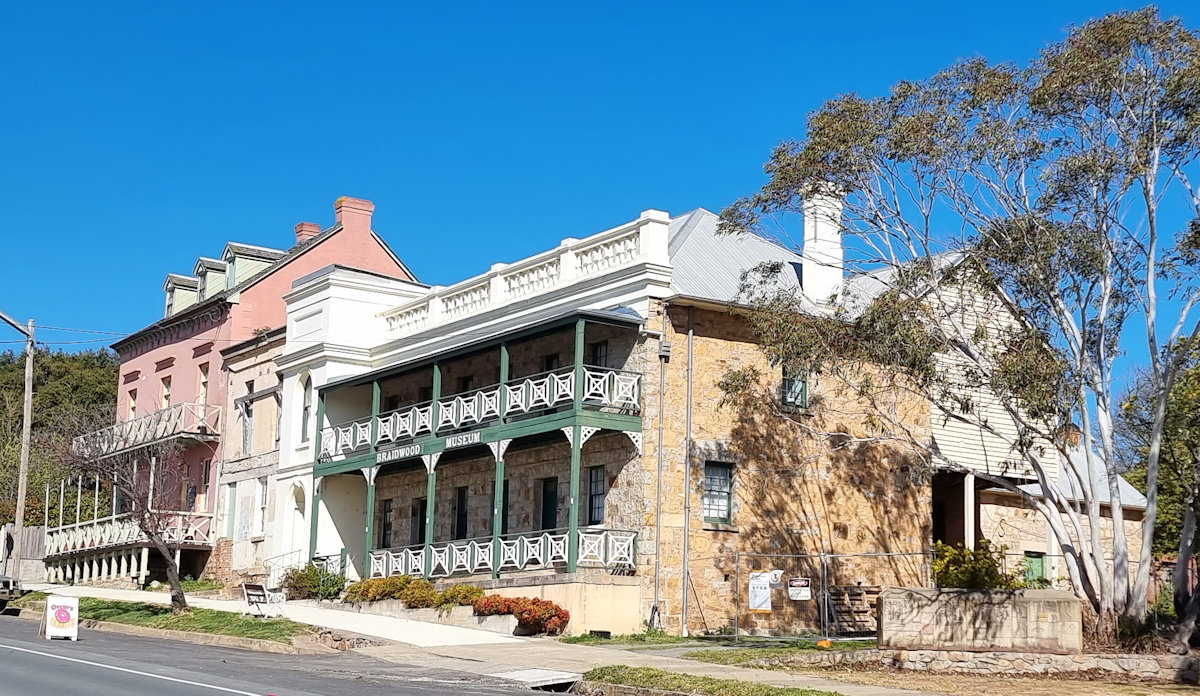Historic Braidwood New South Wales
Braidwood, a heritage town in New South Wales, is located 89 km east of Canberra and approximately 200 km southwest of Sydney. Nestled in the Southern Tablelands, the town is at the gateway to the south coast, making it an ideal stop for visitors exploring both inland and coastal NSW. The town is known for its well-preserved 19th-century architecture and rich history including agriculture and gold mining.
Historical Background
Braidwood’s history dates back to the early 19th century when it emerged as a settlement during the expansion of European colonization. The town was named after Dr Thomas Braidwood Wilson who had been a surgeon-superintendent of ships taking convicts to New South Wales and Van Diemen’s Land (now known as Tasmania). He was first granted land in Van Diemen’s Land in 1824, which he exchanged for land in New South Wales. He and his wife and children settled in the district in late 1836 later becoming a community leader.
By the mid-1800s, the area became a hub for gold mining, attracting prospectors from far and wide. The wealth generated during the gold rush contributed to the construction of grand buildings and infrastructure, many of which remain today. In 2006, Braidwood became the first regional town listed on the New South Wales State Heritage Register, solidifying its place as an important cultural and historical site.
Historical Buildings
Braidwood is home to a rich array of historical landmarks, each with its own story and architectural significance:
St Bede’s Catholic Church
Built of local granite by Richard Hannaford between 1856 and 1862, St Bede’s Catholic Church was originally shingled with wood. However, in the late 19th century the roof was replaced with slate.

Albion Hotel
Built by the MacDonald family in 1872 as the “Modern Hotel”. Considered a luxurious hotel during the late 19th and early 20th century, it had a renowned hostess and a reputation for excellent food. Restored in the early 1980s.

Royal Hotel
Built in 1890 on the site of the earlier Royal Hotel dating from the 1850s. The movie “Ned Kelly” with Mick Jagger was filmed here in 1969.

Braidwood Court House
Built in 1900, the current Court House replaced an earlier building built 1837.

The Braidwood Hotel (formerly the Commercial)
Built in 1859, the hotel is the oldest in Braidwood still licensed. One of the grandest hotels in the Southern Districts of its era, the building features a magnificent ballroom with accommodation rooms above.

Braidwood Museum the former Commercial Banking Company
Built of local granite as the Royal Hotel for the town’s Surveyor, James Larmer, in 1845. The Braidwood Historical Society acquired the building in 1970 and established the Braidwood Museum, custodian to a collection of historical artefacts and memorabilia.

Post Office
Built in 1865 as the Telegraph Office, the Post Office relocated here in the 1890s from McKellar Street. Beside the main building is the Postmaster’s residence.

War Memorial
Located at the intersection of Wilson and Wallace Streets, the War Memorial is also next to Ryrie Park.

Ryrie Park
Reserved at the suggestion of Dr Thomas Braidwood Wilson as a public recreation ground and market square Ryrie Park is a great place to relax after arriving in town. Dr Wilson and other prominent settlers provided exotic plants and flowers for the grounds, and Dr Wilson also presented a brass sundial. His Superintendent Joseph Taylor laid out the grounds and paths. A stamper battery used to crush gold ore is located here as a reminder of the gold rush that built the town’s wealth.


Former Literary Institute now the Queanbeyan-Palerang Regional Council
Completed in 1869, with additions in 1891, the Literary Institute was one of Braidwood’s most significant public buildings. The Institute provided a Library, and encouragement to the community, to educate and improve themselves culturally, while the upstairs Hall was the venue for balls and dances. Between 1958 and 2004 the building housed the Tallaganda Shire Council.

The Commercial Banking Company
The The Commercial Banking Company built this building in 1888 as a bank and bank manager’s residence. The imposing Italianate façade reflects the prosperity of the gold mining era.

Former Masonic Lodge
One of the earliest Lodges in NSW. The residence was built for cabinetmaker Roderick McDonald, who also kept a showroom at this address. The façade has been altered several times to reflect different uses – the present façade was completed in 1907.

The Vanilla Cafe
We stopped in here for morning coffee and cake. Located behind the Commercial Banking Company building, it has a wonderfully relaxed atmosphere. Seating is available inside, or if warm enough, in the garden.



Old Maternity Hospital
The Old Maternity Hospital was operated in the 1860s by Ann Gardiner, sister of local notorious bushrangers known as the Clarke Brothers. Her daughter Eliza Gardiner continued to work there until its closure in 1944. It was formerly known as the Lister Hospital.

St Andrew’s Anglican Church
One of Braidwood’s finest buildings and built of local granite, St Andrew’s Anglican Church features some of the first gargoyles used in ecclesiastical buildings in NSW. The church is styled after the medieval Anglo-Saxon churches of 13th-century Britain. Completed in 1892 the inside contains magnificent stained glass windows and elaborate plaques commemorate pioneer families.



Old Cottage

Trooper’s Rest Restaurant
Trooper’s Rest has been a landmark in Braidwood since the 1840s. Originally opened as ‘The Dog and Style,’ this building has served as a hub for travellers, fortune-seekers, and locals for nearly two centuries. Originally a coach stop for the Araluen Diggings in 1851, Trooper’s Rest has evolved alongside Braidwood, taking on various roles, including a hostel, private residence, and a restaurant. Today, Trooper’s Rest retains its original wooden floorboards, historic doors, and convict-made brick fireplaces

Our photos are available for purchase on
Other Places to Visit in New South Wales
To see what else there is to do in New South Wales, click here.

Leave a Reply